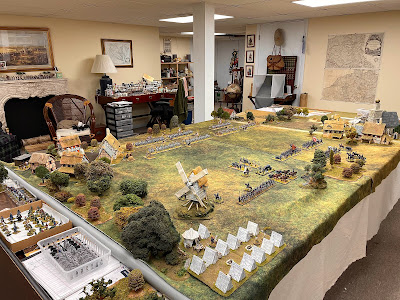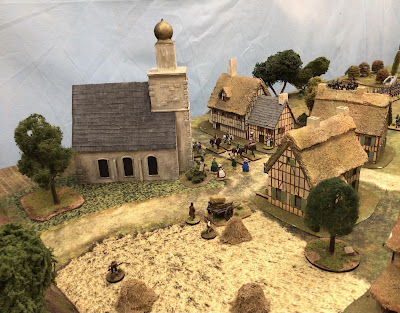 |
| My collection of Ian Weekley buildings on display |
Back in the mid 1980s Ian Weekley was the building modeler par excellence and his models usually graced the pages of Miniature Wargames. Everyone wanted to have an Ian Weekley model, well I did, for sure. So one day I decided to write a letter to Ian at the Old Anchor of Hope and asked him if he was interested in taking on a commission to make the Leuthen Church and some period houses.
We didn't have this Internet Thingy in 1986 so one had to write a letter and usually include some IIRCs (international reply coupons - remember them?) and then hope for a response. To my utter surprise I got a return letter from Ian in which he said that he would be delighted to work on my commission. Over the years I had Ian make some other models for me including a windmill, a city gate and a North German farmhouse.
In retrospect, Ian Weekley's models were rather "quaint" and rudimentary by today's standards. For example, the timbers of a half-timber building were made using indelible markers and window shutters were mere pieces of cardboard that lacked any paint or detail. But at the end of the day, Ian's models were quite lovely and I think that they rather stand up well in today's era.
I decided that it was time to put the Hannibal project on the back burner (it is nearly finished anyway) and get back to painting Minden Miniatures Seven Years War figures. Specifically, I want to get back to the new Austrian and Prussian armies that are based in three ranks on a 60mm by 80mm base. The stands have two rows of soldiers and then there is a thin third rank of officers, NCOs and other file closers. I currently have seven Austrian battalions and three Prussian battalions that I have painted and based in this manner.
I wanted to put the existing units in this project out on my game table and I thought that it would be a great idea to go Old School and bring all of my Ian Weekley buildings out of storage. One nice touch: Ian signed all of his models and wrote down the year that it was made, which tells me how old the model is and when it was made.
The picture below shows my game table. I have enough Ian Weekley buildings to build two villages. I put the villages in the corners of the table so that they do not impede the traffic flow of model soldiers. I also like to turn the buildings on an angle rather than using a rectangle layout. Shifting the rectangle into a diamond shape creates a more interesting focal point for the terrain layout.
 |
| A view of my game table with Ian Weekley models in two of the corners and the windmill on the hill. |
 |
| The church model was made by me! |
 |
| As Phil Olley always says, "every wargaming table needs a windmill." |
 |
| A close up view of some Prussian generals consulting their maps and trying to find there way. |
Ian also made a city gate and tower for me. There is a short section of wall and a half timber house at one end. The interior side of the tower is a clock tower with the clock made from an old watch face. I'd like to make some more walls to use with this model so that I could have a walled town in the corner of my game table Someday.
 |
| The city gate tower model |
 |
| Note the use of an old watch face to make the clock in the clock tower.. The gates are hinged so that they can be opened or closed. |
 |
| One of the town buildings, serving as the local watering hole in this town. |
I have enough Ian Weekly models to make up two villages on the table. The second village is shown in the picture below. Ian made most of the buildings except for the on barely visible in the lower left corner. The town fountain was made by Herb Gundt . The cobblestone streets are a mat made by Lemak, a company that makes Christmas village models.
 |
| The other town on the game table. |
 |
| Another view of the second town. The church spire of the first town can be seen in the distance . |
I am currently painting IR18 Prinz von Preussen for my three ranks basing system. My regiments in both armies have two battalions of 32 figures each. I hope to have the first battalion completed by this coming weekend
Going forward, you can expect to see a lot more 18th Century content on my blog.






Some very nice buildings there - they will certainly enhance any gaming table!
ReplyDeleteA lovely selection buildings
ReplyDeleteGreat to see Weekley buildings in colour! I only remember b & w photos in 80s magazines
ReplyDeleteWhat a treat to see all of your Ian Weekley structures on the table at the same time! And your church goes with them very well. I always enjoyed his articles/tips. Still do.
ReplyDeleteKind Regards,
Stokes
I was fortunate to meet Ian Weekly at a US game convention and asked him to construct a 15 mm fort. Here it is in use for a TSATF game in 2013:
ReplyDeletehttps://ncc1717.files.wordpress.com/2013/12/dscf0027.jpg
correction: Weekley
ReplyDeleteA fascinating and colourful post - all with its own history. I look forward to seeing the new regiment and more 18th century
ReplyDeleteStephen
Thank you for his lovely nostalgia trip. Ian's methods were always a great source of inspiration to my own modelling, and how far sighted of you to buy so many at that time. If you need any more windmills...or other things, you know where to find me. Greatly looking forward to resurgence on 18th Century
ReplyDeleteFantastic display of wargaming and modelling at its best Jim, Ian's articles were always an inspiration.
ReplyDeleteLovely classic buildings!
ReplyDeleteThanks Jim for the pictures. Great to see iIan Weekleys' work up close and in colour! Yours isn't so bad either.
ReplyDeleteI think Ian always really excelled in the way he painted his buioldings.
Nice post Jim... don't blame me for the windmills! I know you love them too!!! Best rgds. Phil
ReplyDeleteWhat an incredible display of buildings and figures you have there.
ReplyDeleteIan Weekley has always been my favorite model maker.